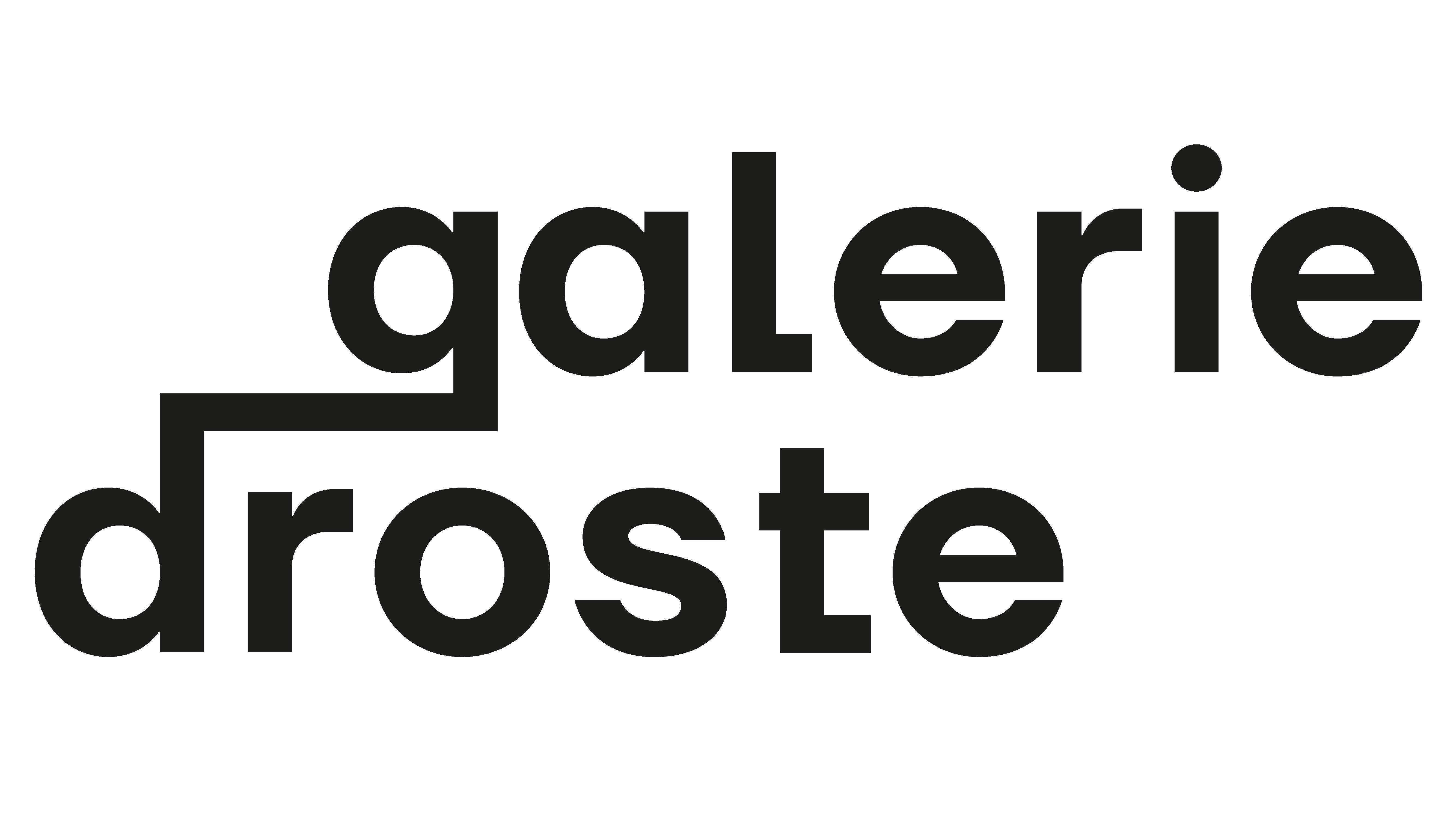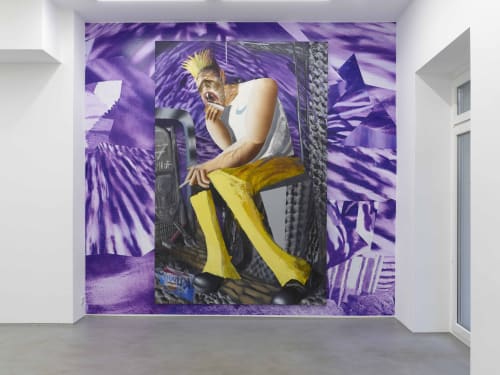Exerpt from Saša Bogojev: Bogus cyber (de)mise-en-scènes
To portray reality via only its polished surface and not its crumbling core can't be the best way to approach representational painting. Not, at least, in the 21st century, when we are keenly aware of the shipwreck that humanity has been steadily navigating toward. When depicting contemporary life, it would only be accurate to include its grotesque, permeating defects. And this is precisely the idea behind Julius Hofmann’s glitchy, jittering scenes of an absurd, digitalized existence verging on post-apocalypse.
Hofmann anchors this idea in simple, often garish, symbols of present-day experience, channeled through a visually pleasing amalgam of traditional western classical painting and 90s computer graphics aesthetics. Take high-end fashion brands or the electric scooter craze. In Prada Milano (2022), modish figures dressed in purple and yellow stroll and scooter through the austere urban environment, fragmented by the polished windows of the Prada store. The skewed perspective and anatomical absurdity add to their clumsiness and mediocrity, with Hofmann employing outdated means of simulating reality as a perfect language to deconstruct and caricature the cracked contemporary life.
Hofmann’s aesthetic carries a sense of urgency. By reducing the scene to vague metaphors, his distilled, ironic, and sarcastic visuals aren't providing or suggesting a full narrative. Instead, they simply present evocative elements as recognizable anchors for ideas and themes. Simultaneously, the consistency in the construction, rendering, and color palette of his images places all his works in the same time and space continuum, establishing connections between otherwise unrelated scenes. As shades of sunshine yellow and luxurious purple tear through an abundance of devitalizing grays, disparate figures are united in a common atmosphere of alienation. Although tiptoeing around abstraction with textures and surfaces that merely suggest brick walls, cobblestones, wire fencing, concrete blocks, etc., the subject, motif, and narrative are still at the core of his work.
Western Philosophies is only one episode in Hofmann’s ongoing confrontation with consumerist society — a way to express concern about his own contribution to the system, or a fear of apathy. In working towards a “good painting” – one that would help deal with his anxiety, frustration, and anger about our predicament – his practice gives the painting process a cathartic purpose. Simultaneously, the resulting visuals can hopefully be experienced as light, fun images – relatable scenes comprising cleverly rendered details that appeal to painting nerds.
The clash of creative energy and emotional charge that fuels Hofmann’s practice culminates in the collage-like approach to building pictures. By patching each image up from individual, seemingly self-contained, elements, and bringing harmony into the chaos, the paintings accrue a decorative value, alongside a range of conflicting emotions. Landscapes, structures, or entire scene designs are presented as mocking monoliths of human megalomania, while the characters that populate these settings are crumpled into banal parodies, embodiments of all the hypocrisies of society.
Through imprecise representation – one that merely suggests the scene and drafts the traces of what’s to be experienced – Hofmann transforms the work from being a one-sided object for observation into a mental playground which engages the viewer regardless of their preexisting knowledge. As shades of sunshine yellow and luxurious purple tear through an abundance of devitalizing grays, disparate figures are united in a common atmosphere of alienation.
When composing his work, Hofmann often seems to be concerned about surroundings, architecture, and ambience before characters. Even when it comes to the depiction of figures, he tends to focus attention on the patterns or surfaces of clothing, the distinctive features of gadgets or nearby machines, and even the occasional bird, dog, and other members of the animal kingdom.
Works like FoxyEyes (2022) or Trekking Teen (2022)are, on the other hand, entirely focused on accentuating the facial features of their female subjects – but only to underline their numb, clichéd appearance. Exaggerated make-up and styling plays to stereotypes of mainstream beauty, while a hyperbolized and sometimes disproportioned perspective further diminishes the relevance of the characters, shifting the focus from individual figure to a societal portrait. Perhaps the most obvious example is Die Tennisspielerin (2022), a nod to Anton Räderscheidt’s homonymous work which sarcastically takes the stereotyped artistic objectification of the female body to new heights – or better, lows.
Where the original work features a clothed man looking at a nude, doll-like tennis player behind the fence, Hofmann’s version removes the male character and places her in a grimy, urban setting. The figure dominates the canvas in her size, and in the start contrast of her polished complexion against her citand the plastic garbage bag resting on the side. The Nike logo shaved into her pubic hair gives her the same branded presence as the Audi in the background while subordinating the viewer into a pervy creep. Situating these zeitgeist details within the long history of painting, Hofmann lends his work a sense of timelessness with a contemporary edge – a finger-pointing critique of the fuckedupness around us.
Hofmann is learned in the formal aspects of classical painting and equipped with a repertoire of traditional techniques to create conventional effect, but he persistently prefers the simplicity of 90s computer graphics over laborious and perfectionist mimesis. He draws, too, on pop art’s mass production and multiplication of ideas, with multiple depictions of the same scene in different sizes, or transportation of the same scene into a different setting.
Again, borrowing from outdated computer graphic exploits, the change of the image definition in regard to its size or focus challenges the traditional language of painting and questions the customary need for refinement. Such work promotes the idea that established definitions or distinctions of movements or styles have become obsolete amid our visual and informational overload. Instead of building on the foundations of respected artistic movements, Hofmann seems to cultivate the accidental and incorrigible mistakes of digital imagery into the arsenal of more traditional artistic tools. This also shifts the source of inspiration from traditional painting to computer graphics, movies, music, and other media — especially disturbing, shocking, and surreal material. In that light, the glitched and imperfect computer graphics give the visuals a new, unexpected value and a hidden meaning. Just as constructivism rejected decorative stylization in favor of the industrial assemblage of materials, Hofmann’s misplaced light sources, nonexistent shadows, disproportionate or detached body parts, skewed perspectives, and simplified patterns revamp the gloomy ambiance and propose a new way of experiencing the scene. In the end, these paintings utilize years of dedicated studio practice while creating a jazzy assemblage of dissimilar elements from art history and contemporary media, converting the experience of 21st-century life into bogus cyber (de)mise-en-scènes.


